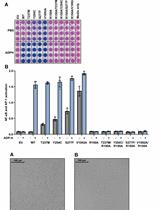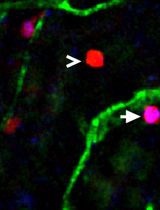- EN - English
- CN - 中文
Measuring Myeloperoxidase Activity as a Marker of Inflammation in Gut Tissue Samples of Mice and Rat
测量小鼠和大鼠肠道组织样本中作为炎症标志物的骨髓过氧化物酶活性
发布: 2023年07月05日第13卷第13期 DOI: 10.21769/BioProtoc.4758 浏览次数: 2454
评审: Pilar Villacampa AlcubierreRajesh ThippeshappaMarieta Ruseva
Abstract
Myeloperoxidase (MPO) is an enzyme contained in lysosomal azurophilic granules of neutrophils. MPO activity has been shown to correlate with the number of neutrophils in histological sections of the gastrointestinal tract and is therefore accepted as a biomarker of neutrophil invasion in the gut. This protocol describes an easy, cost-effective kinetic colorimetric assay to quantify myeloperoxidase activity in intestinal tissue samples. It is explained using tissue collected in mice but can also be used for other laboratory animals. In a first step, tissue specimens are homogenized using a phosphate buffer containing 0.5% hexadecyltrimethylammonium bromide (HTAB), which extracts MPO from neutrophils. The obtained supernatant is added to a reagent solution containing o-dianisidine dihydrochloride, which is a peroxidase substrate. Finally, the change in absorption is measured via spectrophotometry and converted to a standardized unit of enzyme activity. The assay is illustrated and compared to a commercially available enzyme-linked immunoassay (ELISA), demonstrating that MPO activity does not necessarily correlate with MPO protein expression in tissue samples.
Key features
• Optimized for use in mice and rats but can also be used for samples of other species.
• Measures enzymatic activity instead of mRNA or protein expression.
• Requires a spectrophotometer.
• Can be performed in duplo using 10 mg of (dry-blotted) gut tissue or more.
Graphical overview

Background
The presence of inflammatory infiltrates in the gastrointestinal tract is one of the hallmark characteristics of diseases such as ulcerative colitis and Crohn’s disease (Xavier and Podolsky, 2007). The pathogenesis of these diseases is frequently studied in rodents exposed to colitis-inducing chemicals such as acetic acid, dextran sodium sulfate (DSS), and 2,4,6-trinitrobenzene sulfonic acid (TNBS), or in genetically engineered mice that are prone to develop gastrointestinal inflammation spontaneously (Mizoguchi, 2012). To assess which factors contribute to the development, maintenance, and resolution of inflammation in the gut, the availability of sensitive assays to quantify this inflammation is essential.
Several methods are used to quantify the presence of inflammatory infiltrates in the gut. First, the degree of inflammation can be scored by quantifying the shortening and thickening of the intestinal wall via the weight:length ratio of the relevant region within the gastrointestinal tract (Solomon et al., 2010). Second, scoring systems can be used to assess the presence of ulcerations at an endoscopic, macroscopic, or microscopic level (Solomon et al., 2010; Heylen et al., 2013; Erben et al., 2014). Third, quantitative polymerase chain reactions (qPCR), bead-based immunoassays, or conventional enzyme-linked immunoassays (ELISAs) can be used to quantify the expression of pro-inflammatory cytokines such as tumor necrosis factor α (TNF-α) or interleukin 1β (IL-1β) (Khan et al., 2004; Yan et al., 2009; Kim et al., 2012). Finally, myeloperoxidase (MPO) activity can be measured as a biomarker of inflammation. MPO is a peroxidase contained within lysosomal azurophilic granules in neutrophils and released upon activation of the immune system (Schultz and Kaminker, 1962). It has been shown to correlate well with the number of neutrophils in histological sections and is therefore a simple, objective biochemical alternative to the labor-intensive histological analysis of inflammatory infiltrates (Krawisz et al., 1984).
The presence of MPO in tissue samples can be assessed in different ways. First, expression at the mRNA or protein level can be measured by means of qPCR or commercially available sandwich ELISAs, respectively. Second, kinetic assays can be used to evaluate enzymatic activity. In this protocol, we describe a simple, cost-effective kinetic colorimetric assay to determine MPO activity in intestinal tissue supernatant of mice. In addition, we compare our assay to an ELISA, demonstrating that the MPO concentration of the tissue does not necessarily reflect its enzymatic activity. The protocol consists of several steps. First, obtained tissue samples are homogenized in a potassium phosphate buffer containing 0.5% hexadecyltrimethylammonium bromide (HTAB), which solubilizes the enzyme. Next, the supernatant is added to a reagent solution containing o-dianisidine dihydrochloride. This peroxidase substrate turns brownish upon oxidation and can be detected via spectrophotometry (λ = 460 nm).
This protocol was developed and used to measure MPO activity in intestinal tissues of mice and rat (Moreels et al., 2001; Ruyssers et al., 2009; Vermeulen et al., 2011). It could, however, be easily adapted to measure MPO activity in human gastrointestinal biopsies, or in samples derived from other organs. However, spectrophotometric interference by tissue myoglobin or vascular hemoglobin can occur, requiring adaptations of the protocol for organs such as the heart or brain (Kuebler et al., 1996; Xia and Zweier, 1997).
Materials and reagents
Reagents
di-Potassium hydrogen phosphate (K2HPO4) (VWR, catalog number: 71003, CAS number: 7758-11-4), store at room temperature
Dulbecco’s phosphate buffered saline (DPBS), including calcium and magnesium (Gibco, catalog number: 14040133), store at room temperature
Hexadecyltrimethylammonium bromide (Sigma-Aldrich, catalog number: H5882, CAS number: 57-09-0), store at room temperature
Hydrogen peroxide 30% (H2O2) (Merck, catalog number: 107209, CAS number: 7722-84-1), store at 4 °C
o-Dianisidine dihydrochloride (Sigma-Aldrich, catalog number: D3252, CAS number: 20325-40-0), store at 4 °C
Potassium dihydrogen phosphate (KH2PO4) (Merck, catalog number: 104873, CAS number: 7778-77-0), store at room temperature
Sodium chloride 0.9% for injection (NaCl) (B. Braun, catalog number: 76363, CAS number: 7647-14-5), store at room temperature
Deionized water (H2O), prepared using the Elix® water purification system (see Equipment), store at room temperature
Solutions
Potassium phosphate buffer (pH = 6.0) (see Recipes)
Homogenization buffer (see Recipes)
Assay reagent (see Recipes)
Recipes
Potassium phosphate buffer (pH = 6.0)
Prepare a 50 mM KH2PO4 solution by dissolving 6.805 g of KH2PO4 in 1 L of deionized H2O.
Prepare a 50 mM K2HPO4 solution by dissolving 5.706 g of K2HPO4 in 0.5 L of deionized H2O.
Adjust the pH of the KH2PO4 solution by gradually adding the 50 mM K2HPO4 solution, until a pH of 6.0 is reached.
Homogenization buffer
Dissolve 2.5 g of hexadecyltrimethylammonium bromide in 500 mL of potassium phosphate buffer.
Assay reagent (light sensitive; use amber bottles wrapped in silver foil to store this solution)
Prepare a 1% H2O2 solution by adding 100 μL of a 30% H2O2 solution to 2,900 μL of the potassium phosphate buffer.
Prepare a 0.05% H2O2 solution by adding 200 μL of a 1% H2O2 solution to 3,800 μL of the potassium phosphate buffer.
Dissolve 66.8 mg of o-dianisidine dihydrochloride in 4 mL of 0.9% NaCl solution.
Prepare the assay reagents by mixing 4 mL of 0.05% H2O2 solution, 4 mL of the o-dianisidine dihydrochloride solution, and 392 mL of the potassium phosphate buffer.
Laboratory supplies
Cryotubes Cryo.STM, 2 mL (Greiner Bio-One, catalog number: 126263)
Precellys® tubes, 2 mL (Bertin Technologies, catalog number: 9000538)
Cuvettes, 4.2 mL (Sarstedt, catalog number: 67.741)
Reusable oral gavage needle, 10 G × 25 mm (PetSurgical, catalog number: AFN2425S)
Syringe with luer lock tip, 5 mL (Terumo, catalog number: SS*05SE1)
Dissection material (scissors, fine tweezers)
Equipment
Elix® water purification system (Millipore, catalog number: ZLXS50020)
Progard® TL1 Cl2 pretreatment tap water filter (Milli-Q, catalog number: PR0GTLCS1)
Handheld pH meter (Oakton Instruments, model: pH 6+, catalog number: 35613-22)
Precellys® 24 tissue homogenizer (Bertin Technologies, catalog number: P000669-PR240-A)
Centrifuge (Eppendorf, catalog number: 5425R)
UV/Vis Spectrometer (ATI Unicam, model: UV2-100)
Software
Excel® (Microsoft) or any other software suitable for basic data manipulation
Procedure
文章信息
版权信息
© 2023 The Author(s); This is an open access article under the CC BY-NC license (https://creativecommons.org/licenses/by-nc/4.0/).
如何引用
Hanning, N., De Man, J. G. and De Winter, B. Y. (2023). Measuring Myeloperoxidase Activity as a Marker of Inflammation in Gut Tissue Samples of Mice and Rat. Bio-protocol 13(13): e4758. DOI: 10.21769/BioProtoc.4758.
分类
免疫学 > 免疫细胞功能 > 嗜中性粒细胞
生物化学 > 蛋白质 > 活性
您对这篇实验方法有问题吗?
在此处发布您的问题,我们将邀请本文作者来回答。同时,我们会将您的问题发布到Bio-protocol Exchange,以便寻求社区成员的帮助。
提问指南
+ 问题描述
写下详细的问题描述,包括所有有助于他人回答您问题的信息(例如实验过程、条件和相关图像等)。
Share
Bluesky
X
Copy link











